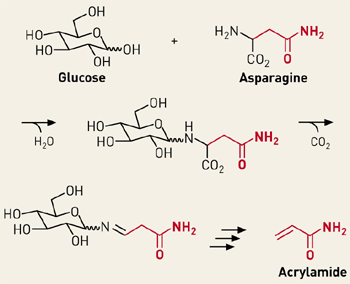Acrylamide: why french fries shouldn't be overheated

Introduction
America's most popular vegetables -- golden brown french fries and crispy potato chips -- aren't just loaded with fat and sodium. Starchy fried food also contain a chemical called acrylamide that is quietly raising concern as a potential human carcinogen.
Analysis of acrylamide, a carcinogen formed in heated foodstuffs, 2002
Acrylamide forms when sugars and an amino acid called asparagine are heated together at high temperature -- more than 120 degrees Celsius (boiling occurs at 100 degrees). This effect, part of what's called the Maillard reaction , enhances food's color, flavor, aroma and texture.


Toxicity and carcinogenicity
Some evidence suggests that exposure to large doses can cause damage to the male reproductive glands. Direct exposure to pure acrylamide by inhalation, skin absorption, or eye contact irritates the exposed mucous membranes, e.g., the sinuses, and can also cause sweating, urinary incontinence, nausea, myalgia, speech disorders, numbness, paresthesia and weakened legs and hands.
In addition, the acrylamide monomer is a potent neurotoxin, causing the disassembly or rearrangement of intermediate filaments.
Effects of acrylamide on the central nervous system of the cat, 1958
Ingested acrylamide is metabolised to a chemically reactive epoxide, glycidamide.
Chemical risks in food, 2010
Occurrence in food and associated health risks
Later studies have found acrylamide in black olives, prunes, dried pears and coffee. Estimates for the proportion of acrylamide in adults' diet are coming from the consumption of coffee range from 20% to 40%; prune juice has a high concentration of acrylamide, though adults consume it in far smaller quantities.
Acrylamide detected in prune juice and olives, 2004
Acrylamide in dried fruits, 2007

Although acrylamide has known toxic effects on the nervous system and fertility, a June 2002 report by the Food and Agriculture Organization of the United Nations and the World Health Organization concluded that the intake level required to observe neuropaty (0.5 mg/kg body weight/day) was 500 times higher than the average dietary intake of acrylamide (1 µg/kg body weight/day). For effects on fertility, the level is 2,000 times higher than the average intake. From this, they concluded that acrylamide levels in food were safe in terms of neuropaty, but raised concerns over human carcinogenicity based on known carcinogenicity in laboratory animals.
FAO/WHO Consultation on the Health Implications of Acrylamide in Food, 2002
To determine the human risk from acrylamide, several studies have been conducted using food frequency data to estimate acrylamide intake and its effect on cancer risk.

Conclusions
An EFSA (European Food Safety Authority) statement in 2005 noted that there may be a potential health concern with acrylamide which is known to be both carcinogenic and genotoxic.
The statement endorsed the conclusions and recommendations of a previous risk assessment on acrylamide carried out by the Joint FAO/WHO Expert Committee on Food Additives (JECFA). In this assessment, JECFA concluded that acrylamide may indicate a human health concern and that efforts should be made to reduce exposure.
Acrylamide levels in food vary widely depending on the manufacturer, the cooking time and the method and temperature of the cooking process.
The best advice at this time is to follow established dietary guidelines and eat an healthy, balanced diet that is low in fats and rich in high-fiber grains, fruits and vegetables.
